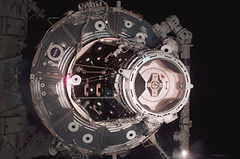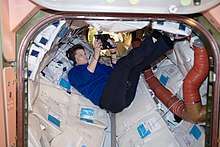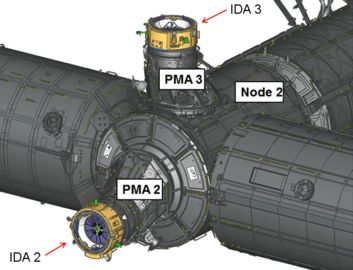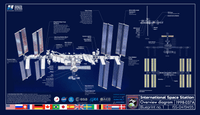Pressurized Mating Adapter
The Pressurized Mating Adapter (PMA) is a class of spacecraft adapters that convert the Common Berthing Mechanism (CBM) used on the US Orbital Segment to APAS-95 docking ports. There are three PMAs located on the International Space Station (ISS); the first two were launched with the Unity connecting module in 1998 aboard STS-88, and the third was launched in 2000 aboard STS-92.
 PMA-2 attached to the forward port of Destiny, where it was located between 2001 and 2007 | |
| Module statistics | |
|---|---|
| Part of | International Space Station |
| Launch date |
|
| Launch vehicle | Space Shuttle |
| Docked |
|
Uses

The three PMAs are identical,[1] but they have slightly different uses. All three perform the same basic function of connecting a CBM port of an ISS module to an APAS-95 docking port of another module or visiting spacecraft.[2] For this purpose, the PMAs carry a passive CBM port and a passive APAS port. The PMAs are pressurized and heated from the inside, and they allow for power and data communications transfer through docking rings and external connections.[3]
PMA-1
This was one of the first components of the International Space Station. PMA-1 joins the Russian side of the station with the US side. On STS-88, the crew used the shuttle's robotic arm to attach the Zarya control module to PMA-1, which was already connected to the aft berthing port of Unity. These first two station components are permanently connected by PMA-1.
PMA-2

PMA-2 is mounted on the forward port of the Harmony connecting node, and was used when Space Shuttle orbiters docked at the ISS. It was outfitted with Station-to-Shuttle Power Transfer System (SSPTS) hardware to allow the shuttles to stay docked longer to the space station.[4]
PMA-2 has been moved several times as part of the ongoing space station assembly process. It was originally connected to the forward hatch of Unity, but when STS-98 delivered the Destiny module in February 2001, PMA-2 was moved to the berthing ring of the Z1 truss so that Destiny could be berthed to the forward hatch of Unity. PMA-2 was finally moved to the forward hatch of Destiny.[5] (The removal of PMA-2 from Unity was the first time the CBM had been used to disconnect two ISS components.)[6] After STS-120 had delivered Harmony to the space station in October 2007, Canadarm2 repositioned PMA-2 at the forward port of Harmony on November 12, 2007. Two days later, the combined package of Harmony and PMA-2 was moved to its final location, the forward hatch of Destiny. As of 2020, PMA-2 is expected to stay berthed at the forward port of Harmony for the remaining duration of the ISS.
When a shuttle docked with the station, its "final approach [was] at a relative velocity of one-tenth of a foot per second. [As it made] contact with Pressurized Mating Adapter 2 [latches] automatically attached the two spacecraft together. Once relative motion between the spacecraft stopped, [a Shuttle astronaut retracted] the docking ring on [the Shuttle's] mechanism, closing latches to firmly secure the shuttle to the station."[7]
On July 18, 2016, International Docking Adapter-2 was launched on SpaceX CRS-9.[8] It was attached and connected to PMA-2 during a spacewalk on August 19, 2016.[9]
PMA-3
PMA-3 was brought to the ISS by STS-92 in October 2000, mounted on a Spacelab pallet.[10] It was initially attached to the nadir (bottom, or Earth-facing) hatch of Unity. About six weeks later, when STS-97 delivered the P6 solar array truss structure, Endeavour docked at PMA-3.[11] When STS-98 moved PMA-2 from Unity to Destiny via the Z1 truss in February 2001, Atlantis was docked at PMA-3.[5] For the remainder of the shuttle's operation, PMA-3 was not used for shuttle dockings. PMA-3 was moved in March 2001 to Unity's port hatch by the crew of STS-102 to make room for the docking of a Multi-Purpose Logistics Module (MPLM).[12]
On August 30, 2007, PMA-3 was returned to the nadir port of Unity to make room for the temporary docking of the new Harmony (Node 2) module that was delivered by STS-120.[13] Harmony was transferred to the forward port of Destiny, while PMA-3 was moved back to the port berthing mechanism of Unity on August 7, 2009, to accommodate reconfiguration of the Unity port bulkhead by crew members in a pressurized environment.[14] On January 25, 2010, PMA-3 was moved from the port berthing mechanism of Unity to the zenith (space-facing) port of Harmony to make room for the new Tranquility (Node 3) module which was added to the station during STS-130. After activation of Tranquility, PMA-3 was moved again on February 16, 2010, to the port location on Tranquility where the Cupola observatory module had been docked for launch.[15]
PMA-3 was robotically removed from Tranquility on March 26, 2017, and attached to Harmony after being prepared during a successful spacewalk on March 24, 2017. A second spacewalk was conducted on March 30, 2017, to finalize the PMA-3 cable connections on Harmony. PMA-3 received International Docking Adapter-3 in August 2019.[16]
References
- Nasa.gov – Elements
- "Human Space Flight – Space Fact". NASA. July 4, 2002. Retrieved January 17, 2007.
- "STS-92 Press Release Kit: Payload section". NASA. October 10, 2000. Retrieved October 27, 2007.
- "International Space Station Status Report #07-08". NASA.
- STS-98, Mission Control Center (February 10, 2001). "Status Report # 07". NASA. Retrieved January 18, 2007.
- Harwood, William (February 10, 2001). "Atlantis crew to attach Destiny lab to station today". Spaceflight Now. Retrieved January 15, 2007.
- STS-102, Mission Control Center (March 9, 2001). "Status Report # 03". NASA. Retrieved January 18, 2007.
- Jason Rhian (July 18, 2016). "SpaceX Conducts Second Ground Landing After Launch Of CRS-9 Dragon To ISS". Spaceflight Insider.
- Harwood, William (August 19, 2016). "Spacewalkers attach docking adapter to space station for commercial vehicles". Spaceflight. Retrieved August 20, 2016.
- STS-92, Mission Control Center (October 16, 2000). "Status Report # 10". NASA. Retrieved January 18, 2007.
- STS-97, Mission Control Center (December 2, 2000). "Status Report # 05". NASA. Retrieved January 18, 2007.
- STS-102, Mission Control Center (March 11, 2001). "Status Report # 07". NASA. Retrieved January 18, 2007.
- "SHUTTLE/SOYUZ/ISS PROCESSING MILESTONES". CBS News.
- "NASA - 08-07-2009 ISS On-Orbit Status". www.nasa.gov. Retrieved June 3, 2017.
- STS-130, Mission Control Center (February 16, 2010). "Status Report # 17". NASA. Retrieved February 16, 2010.
- Pietrobon, Steven (August 20, 2018). "United States Commercial ELV Launch Manifest". Retrieved August 21, 2018.
External links
| Wikimedia Commons has media related to Pressurized Mating Adapters. |
- YouTube animation Canadarm2 and Dextre move the PMA-3 between locations, one of the five times it was moved so that modules could use a Common Berthing Mechanism port instead of PMA-3.
